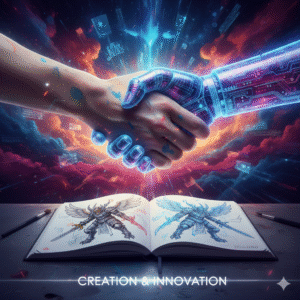Meet Sarah. She’s a brilliant graphic designer, but today, she’s staring at a blank screen. Her mission? Create a complete brand identity for a new, local, eco-friendly coffee shop called “Earthly Beans.” She needs a logo concept, tagline ideas, a mission statement, and even some social media posts. She’s feeling stuck, overwhelmed, and completely uninspired. The cursor blinks, mocking her. (example of using roles in prompt engineering)
This is a problem every creative person faces. We call it “the blank page.” But what if Sarah could instantly brainstorm with a world-class branding expert, a witty copywriter, and a sharp marketing strategist, all at once, for free? This isn’t a far-fetched dream. This is a practical example of using roles in prompt engineering, a simple technique that is completely changing the game for human-AI collaboration for creators.
If you’ve ever tried using AI and felt “meh” about the results, it’s probably because you were giving it a task, not a job. There’s a huge difference. Stick around, and I’ll show you how to transform your AI from a simple calculator into a creative partner that can help you build an entire brand from scratch.
What is Prompt Engineering (And Why Does “Role-Playing” Matter?)
Let’s break this down like you’re 10 years old.
Imagine you have a super-smart friend who can do anything, but you have to give them instructions. This is the AI (like ChatGPT, Gemini, or Claude).
A “prompt” is just the instruction you give them.
- Bad Prompt: “Write about coffee.”
- Good Prompt: “Write a paragraph about why coffee is popular.”
“Prompt engineering” is just the fancy term for figuring out the best way to ask for what you want.
Now, what is “using roles”?
Think of the AI as the world’s greatest actor. It can play any part you give it. If you just say, “Write a tagline for a coffee shop,” the AI is like an actor on a bare stage with no script. It will say something, but it will be boring and generic.
But, if you give it a role, everything changes.
“I want you to act as a witty, world-class copywriter from the 1960s. Your client is a new coffee shop. Give me five catchy taglines.”
By giving the AI a role (a job, a personality, a point of view), you give it guardrails. You give it context. This focused constraint is the secret to unlocking AI and creativity. The AI stops being a simple tool and becomes a specialist collaborator.
Sarah’s First Try: The “No-Role” Prompt (And Why It Fails)
Back to Sarah. Frustrated, she opens an AI chat window and types:
Prompt: “Give me ideas for a sustainable coffee shop.”
The AI, doing its best, gives her a very literal, very boring list:
- Use recycled materials for cups.
- Source fair-trade coffee beans.
- Offer discounts for customers who bring reusable cups.
- Use energy-efficient lighting.
Sarah groans. This isn’t creative; it’s a “to-do” list. It doesn’t help her build a brand. The problem wasn’t the AI; it was her prompt. She was asking for information, not creation.
The Breakthrough: An Example of Using Roles in Prompt Engineering in Action
Sarah takes a deep breath and decides to try something different. Instead of just asking for “ideas,” she’s going to build a virtual creative team.
Step 1: Hiring the Brand Strategist
First, Sarah needs the big-picture vision. She needs to define the brand’s heart.
Prompt: “I want you to act as a world-class brand strategist. Your client is ‘Earthly Beans Coffee,’ a new shop focused on 100% organic sourcing, community, and transparency. The target audience is environmentally-conscious millennials and Gen Z. Your task is to develop a core brand identity. Please provide:
- A powerful Mission Statement.
- Three core Brand Values.
- A unique Selling Proposition (USP).”
The AI’s Response (as Brand Strategist):
- Mission Statement: “To connect our community to the source of their coffee, fostering a culture of sustainability and conscious consumption, one cup at a time.”
- Brand Values:
- Transparency: We proudly share the journey of our beans, from farm to cup.
- Community: We are more than a coffee shop; we are a local hub for connection and ideas.
- Earth-First: Every decision we make is guided by its impact on the planet.
- USP: “Earthly Beans: The only local coffee shop that is 100% transparent about its supply chain, so you can taste the quality and trust the source.”
Suddenly, Sarah has a rock-solid foundation. She has a “why.” This is a perfect example of using roles in prompt engineering to get expert-level results.
Step 2: Hiring the Witty Copywriter
Now that she has a strategy, she needs a voice.
Prompt: “You are a clever, warm, and slightly witty copywriter (think of a brand like Innocent Drinks or Oatly). Using the Mission, Values, and USP from above, write 10 tagline options for ‘Earthly Beans Coffee.'”
The AI’s Response (as Witty Copywriter):
- Sip like you give a damn.
- Earthly Beans: Good for your soul. Great for the soil.
- Taste the story in every cup.
- Your daily ritual, responsibly sourced.
- Coffee that loves the Earth back.
- Be grounded. Drink Earthly.
- Conscious coffee for a conscious community.
- The future of coffee tastes this good.
- From a good place, to your favorite mug.
- Wake up on the right side of the planet.
This is worlds better than “use recycled cups.” Sarah now has 10 fantastic options to present to her client. This kind of human-AI collaboration for creators just saved her hours of agonizing brainstorming.
Step 3: Hiring the Social Media Manager
Sarah has her brand and her tagline (“Sip like you give a damn” is the winner). Now she needs to launch it. Time to automate her workflow.
Prompt: “You are a savvy social media manager who is an expert at building an organic Instagram following for local businesses. Based on the ‘Earthly Beans’ brand identity (transparent, community-focused, witty voice), create a 7-day content plan for our launch week. For each day, provide the post theme, a visual idea, and a caption.”
The AI’s Response (as Social Media Manager):
- Day 1: The Tease
- Theme: Something new is brewing.
- Visual: A close-up, beautifully lit shot of dark coffee beans spilling from a burlap sack.
- Caption: “Shhh… Can you keep a secret? We’ve been working on something that’s good for the planet and great for your morning. Get ready, [Her City]. #SipLikeYouGiveADamn”
- Day 2: The “Why”
- Theme: Our Mission.
- Visual: A simple text graphic with the mission statement: “To connect our community to the source, one cup at a time.”
- Caption: “We’re not just another coffee shop. We’re Earthly Beans, and we believe in 100% transparency. That means you know exactly where your coffee comes from. It’s time to feel good about your daily ritual.”
- Day 3: Meet the Farmer
- Theme: Transparency in Action.
- Visual: A carousel post. First image is a photo of a coffee farmer (a stock photo Sarah can license). The next slides are info about the farm in Peru.
- Caption: “Meet Maria! She’s the farmer behind our ‘Peru Peaberry’ single-origin. Her farm is shade-grown and bird-friendly, and we pay her 20% above the fair-trade price. This is what ‘Earthly’ means.”
…and it continues for all 7 days.
In under an hour, Sarah has used AI as a strategist, a copywriter, and a social media manager. She’s not replaced; she’s amplified. She’s the creative director, and AI is her highly efficient team. This is the future of AI and creativity.
Why This Simple Trick Changes Everything
Using roles is the single most effective way to improve AI-generated content. Here’s why it works so well.
- It Banishes Generic Answers: When you assign a role, you force the AI to adopt a specific tone, style, and knowledge base. This immediately filters out all the generic, boring language and gives you something with personality.
- It Provides Specific Constraints: Creativity thrives on constraints. By saying “You are a 1950s advertiser” or “You are a Gen Z TikTok-er,” you are giving the AI a very specific box to play in. This prevents it from trying to be everything to everyone and results in sharper, more useful output.
- It Unlocks Niche Expertise: You don’t have to be an expert in everything. You can “hire” an expert. Need to understand a complex legal document? “Act as a lawyer and explain this to me like I’m 10.” Need to write code for a website? “Act as a senior front-end developer.” This is the core of creative workflow automation: using AI to fill the gaps in your own skillset, instantly.
Mastering this one technique is more important than knowing 100 different “prompt hacks.”
Real-World Examples: How Professionals Are Using AI Roles
This isn’t just for designers. This method is being used across all industries.
- Case Study 1: The Author & The Editor: Bestselling author and Wharton professor Ethan Mollick often uses AI as a collaborator. Instead of asking “Is this chapter good?” he’ll prompt: “You are a harsh but fair developmental editor at a major publishing house. Read this chapter and give me 5 concrete points of criticism to make the plot stronger.” This human-AI collaboration for creators provides actionable, specific feedback.
- Case Study 2: The Startup & The “Ideal Customer”: A small software company wanted to test its new product’s landing page. They prompted their AI: “You are ‘Startup Steve,’ a 35-year-old project manager who is overwhelmed by emails. Read this landing page and tell me what your biggest objections are.” This “customer persona” role-play helped them identify weaknesses in their marketing before it went live.
- Case Study 3: The Teacher & The Socratic Tutor: A high school history teacher uses AI to create better study guides. She prompts: “You are Socrates. You must teach me about the American Revolution by only asking me questions. Do not give me the answers directly.” This encourages critical thinking, a fantastic example of using AI for education.
Your AI “Dream Team”: 4 Tools to Get You Started
Ready to build your own team? While many AI tools exist, these are fantastic for role-playing.
- Google Gemini: (That’s me!) I’m deeply integrated with Google Search, which means I can pull in real-time information. This is perfect for roles that need up-to-date knowledge, like a “Market Analyst” or “Trending News Reporter.”
- OpenAI’s ChatGPT (GPT-4o): The famous all-rounder. It’s incredibly versatile and excels at creative writing, coding, and complex problem-solving. It’s the “Swiss Army Knife” on your team. (Source: OpenAI.com)
- Claude: Developed by Anthropic, Claude is known for its large “context window” (it can “read” a whole book or a long report) and its very natural, human-sounding writing style. It’s great for roles like “Editor” or “Summarizer” for large documents.
- Perplexity AI: This is your “Research Assistant.” It’s designed to answer questions and provide detailed sources and citations. When you need a role that backs up its claims with data, Perplexity is a great choice.
A Beginner’s Guide to Building Your First AI Role Prompt
Ready to try? Don’t just copy and paste. Use this 4-part formula.
- Role (The “Who”): Start with “Act as…” or “You are…” Be specific.
- Good: “You are a doctor.”
- Better: “You are an empathetic pediatrician explaining a vaccine schedule to a new, anxious parent.”
- Task (The “What”): Tell them exactly what you want them to do.
- Good: “Write an email.”
- Better: “Write a brief, professional email to my boss.”
- Context (The “Why”): Give them all the background info they need to succeed.
- Good: “The email is about being sick.”
- Better: “The email is to tell my boss, Susan, that I have the flu and can’t come in today. I need to let her know I will miss the 10 AM project meeting but will check emails in the afternoon if I feel better.”
- Format (The “How”): Specify the output you want.
- Good: “Just write the email.”
- Better: “Give me three different subject line options. Keep the email under 100 words. Use a professional but friendly tone.”
Putting it all together:
“Act as an empathetic pediatrician explaining a vaccine schedule to a new, anxious parent. Write a simple, reassuring script I can read that explains why the 2-month vaccines are important and what common, mild side effects to expect. Please use simple, non-medical language and structure it as a Q&A.”
This level of detail is a fantastic example of using roles in prompt engineering, and it will give you a useful, high-quality response every time.
Prompt Dependency ABA: Is Your AI Crutch Killing Your Creativity? (Here’s How to Fix It)
Your New Creative Workflow is Here
The fear that AI will replace creators is misplaced. AI is a tool—the most powerful tool we’ve ever had. It doesn’t replace the artist; it replaces the grunt work.
By learning to use roles, you’re not just getting better answers. You’re building a team of on-demand experts. You’re automating the boring parts of your creative workflow automation (like writing 10 versions of a tagline) so you can focus on the human parts (like deciding which tagline feels right).
Sarah’s story didn’t end with the AI’s output. She took those ideas, refined the logo concept, tweaked the tagline, and presented a stunning brand package to her client. The AI didn’t do her job; it allowed her to do her job better and faster.
This is the new landscape of AI and creativity. The future belongs to those who don’t just use these tools, but who learn to lead them. So go ahead: hire your dream team.
ChatGPT Studio Ghibli Prompt Secrets: Instantly Create Hayao Miyazaki-Style Art
Blog Post Deliverables:
- Title: Example of Using Roles in Prompt Engineering That Will 10x Your Creativity
- Meta Description: See a powerful example of using roles in prompt engineering. Learn to 10x your creative workflow.
- SEO Slug:
example-using-roles-prompt-engineering-creativity - Image Prompt: A split-screen graphic. On the left, a frustrated female designer looks at a blank computer screen. On the right, the same designer smiles, collaborating with a friendly, glowing AI assistant icon on her screen, which is now full of ideas.
- Image Alt Text: A designer using an example of using roles in prompt engineering to improve her creative workflow with AI.
- Tags: example of using roles in prompt engineering, human-AI collaboration for creators, AI and creativity, creative workflow automation, AI for freelancers, prompt engineering tips, generative AI, AI productivity, marketing with AI, content creation AI, AI for designers
- Keyword List: example of using roles in prompt engineering, human-AI collaboration for creators, AI and creativity, creative workflow automation, AI for creators, prompt engineering tips, generative AI
- Category: AI for Freelancers & Creators



